AI-UBREM; Vienna Positive Energy District Initiative
Concept
As rapid urbanization is escalating, increasing energy demand is expected. Consequently, affecting climate change and global warming. Moreover, Energy is on the top in the number of points in buildings and neighborhood green rating systems, like LEED, BREEAM, and CASBEE. The energy use-pattern of buildings is a shared concern as architects, engineers and planners are exploring diverse approaches to consolidate future solutions.

Vienna Problem
Do you know a house in Vienna contributes to 34% of the city’s energy consumption?

Solution
The proposed solution to this is to reduce the energy consumption and Increase the sources for generating renewable power production (in our case we are focusing on solar as the renewable energy).

A proposed Scenario is to explore retrofitting your building. A single insulation layer painted to your wall can spare you almost 1/3 of the building’s energy consumption. Adopting an easy-to-apply passive design strategy is essential to integrating residents and developers into district energy consumption. Moreover, promoting tools like urban building energy modeling (UBEM) with renewable energy resources and generating on-site energy more than the demanded manifest the idea of positive energy district (PED).
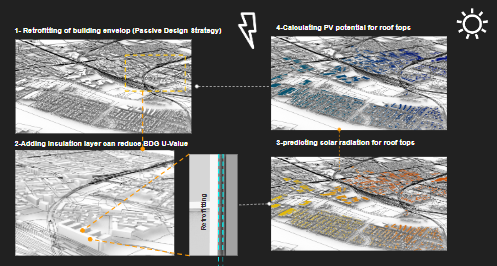
Methodology
This project implements 3 main steps. At first, building a dataset of building geometry, geographic data, and energy consumption (EC). Secondly, training ANN regression and SL regression and comparing results. At last, deploying a prediction for both EC and solar radiation for PV potential.
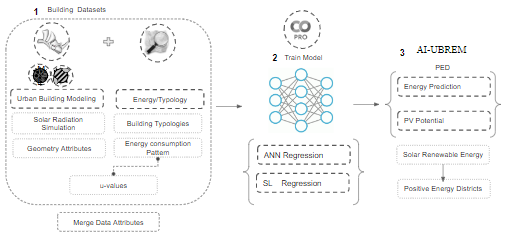
Pseudo Code
Five main steps are undertaken to build a dataset, code for integrating the geodata with energy statistics, and consolidating renewable energy potential including solar, geothermal, biomass, and wind. However, the final results manifested only PV potential. This pseudo-code addresses the district energy scale aiming at GNN to investigate the smart grid and distributed generation perspective of the city 22 districts.

DataSet
1-Geographic Dataset
Geographic data is retrieved from OSM together using colab different libraries to process geometric attributes, location and buildings’ shape and height as tags.
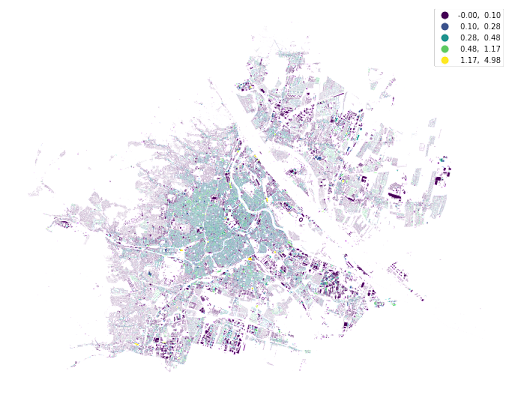
In addition, Particular points location were used to integrate energy data t geometric one and train the AI ANN regression model for solar prediction and energy prediction. Geometric attributes are essential for solar radiation prediction. While for the energy scenario, it assisted in altering the u-value of roof, windows, basement, and walls.
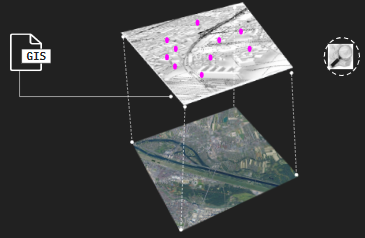
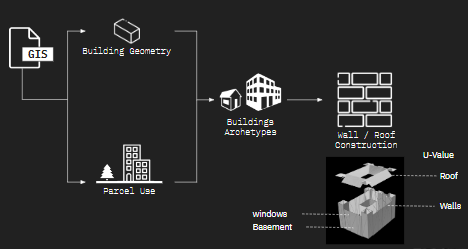
At the end, GIS data with energy and simulation results are utilized to train 2 AI-model ANN regressions with different architectures.
2-EnergyData
Simultaneously, a data scraping is done to get u-values for Vienna buildings’ envelope for walls, basement, roof, and windows with a corresponding energy consumption of heating, cooling, and DHW (Daily heating water) which represents the main points of interest to all researchers and developers working on Vienna.
Available Energy data is fetched from multiple UN-co_funded projects taken place on Vienna. Hence, the main focus was on 5 main building typologies as entitled by the OSM tags; apartments, single family /detached, residential, office, and school.
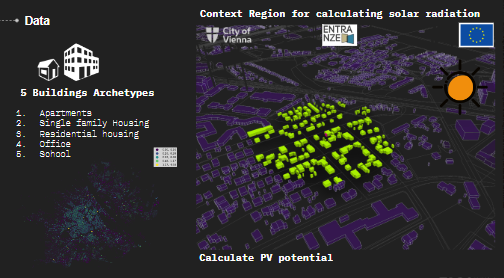
3-Simulation Results
At last, this project needs renewable energy resources and reliable data to build and manifest PED ideation. Hence, as architects, we chose to implement solar radiation simulation to link it with PV potential. District energy opts to cover its consumption with other RE resources like geothermal, biomass, and in some regions in Vienna wind potential.
![]()
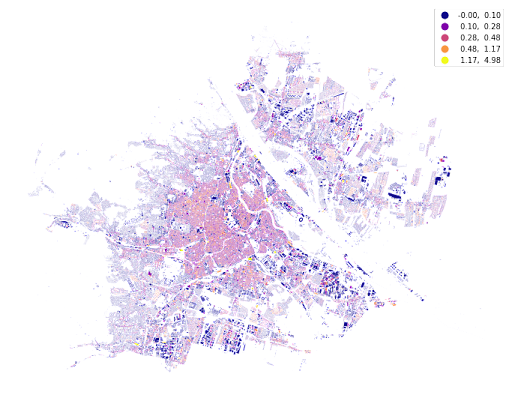

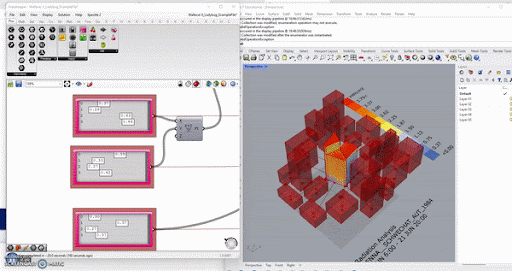
Results
In order to manifest positive energy district (PED) conceptualization, On-site renewable energy generation should be more than the buildings’ energy demand (BED). ANN regression is trained to predict buildings’ energy consumption once, and another architecture of the same algorithm is trained to predict solar radiation, hence PV potential.

User-Story
Users include tenants, owners, real-estate developers, architects, and energy engineers addressing energy district-level. So either for retrofitting scenarios adopting passive design strategies or techniques of the same building, altering building use/typology, or even adding new construction to fill in vacant land, energy consumption prediction is essential to increase the value of your asset as an energy-saving, energy-efficient design to gain green buildings’ certification such as LEED or BREEAM.
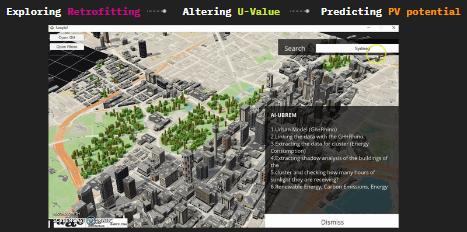
Webpage showcase
The Implemented webpage at the moment demonstrates the first scenario of predicting energy consumption after retrofitting to alter the u-value for walls, basement, windows, and basement using a simple passive design technique like adding an insulation layer, applying a double-skin, or louvers to decrease the final u-value. The webpage provides geo-referenced layers for five buildings’ typology /archetypes, residential, detached house, apartments, school, and office.
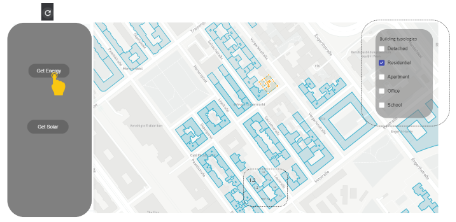
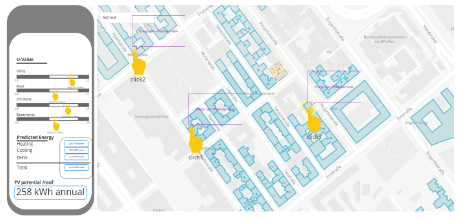
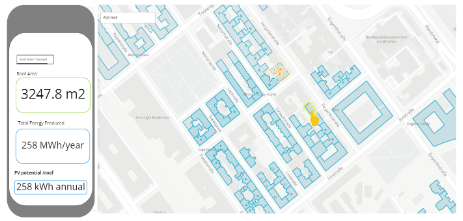
Moreover, Upon experimenting with a new u-value for these building envelopes and layers, PV potential will assist PED conceptualization by comparing the BED, predicted consumption, and Renewable energy generation, bearing in mind that the district energy on-site or distributed generation implementation doesn’t solely rely on solar, as clarified earlier, Vienna’s district energy is distributed among other renewable resources.
Future Potential
The main aim of this project is to manifest PED through UBREM ( urban building renewable energy modeling) which requires a profound study of different renewable energy resources, Vienna case study possibilities, and trajectories. Furthermore, it complies with district energy share and distribution among other buildings. On the microlevel, it involves building use patterns throughout diverse scenarios per building typology.
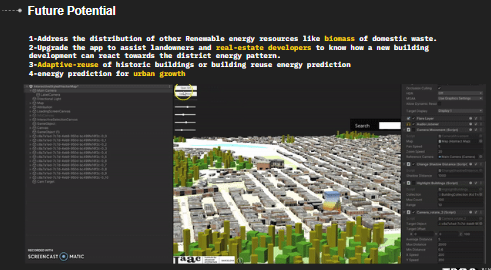
PED is not only about existing buildings, it includes future urban growth, building adaptive reuse with different use patterns than the ones it was built for, in addition to new development and construction that influence the district’s energy management plan.
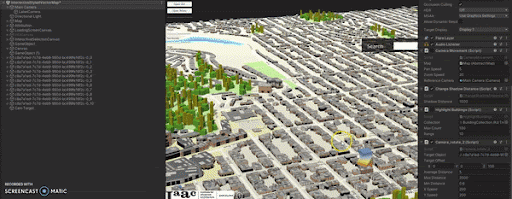
Link to online App
Some updates are taking place to upgrade the proposed application results and options.
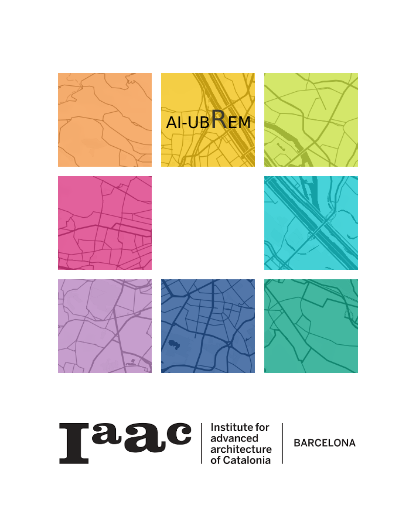
Students: Sammar Z. Allam + Naitik Sharma + Alexander Lopez.
Faculty: Chronis Angelos.
Faculty Assistant: Serjoscha Duering+ Aleksandra Jastrzebska + Nariddh Khean.
Faculty director: David Leon.